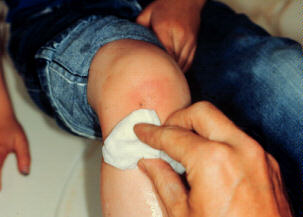| Abrasions |
This page is sponsored by WoundCareShop,
your on-line source for first aid supplies such as non-stick pads,
gauze, and wrapping. See our link below in the treatment section. |
Scenario: We're all familiar with abrasions. If you don't get scraped up, you aren't
really mountain biking. Most biking abrasions involve knees, back of the elbows and upper
forearm, and shoulders.
Description:
An abrasion is a scrape. It's caused by a rubbing injury that strips off the outer layers
of skin. Large and deep abrasions are more serious. (If the injury changes shape
significantly when pulling on the skin, or it fat tissue is seen, this is NOT an abrasion
-- it's a full-thickness avulsion, a complete loss of all layers of the skin.)Typical "sandstone kiss" from dropping a knee down
during a four-point landing from an endo. |

|
Concerns:
Any deep abrasion will leave some scar tissue behind. On the face, scars are unsightly.
Over joints, a bad scar may prevent full motion. Proper treatment will minimize the scar,
making it less noticeable and reducing stiffness. An abrasion is often contaminated
with dirt, gravel, and other foreign material. Infection is a risk, especially with deep,
crushed, or dirty abrasions. In some severe abrasions, the skin will die -- leaving the
equivalent of a third-degree burn.
See the doctor if:
there is mushy tissue exposed that changes shape easily
the scrape is extremely dirty or won't come clean
the scrape is very large
the scrape is on a critical area: face, genitals, hands
| An abrasion should hold its shape when the skin is moved or stretched. If
any part of the wound gapes or changes shape, this is a more serious injury. This abrasion, caused by a high-speed touchdown on the back of
the forearm, has a gouge in the center that exposes fat. This injury should be treated by
your doctor. |

|
 |
Immediate care:
Relieve pain with an anesthetic spray or pain relieving gel. Wash the scrape thoroughly.
If necessary, soak in the tub. The quicker you start scrubbing the abrasion, the less it
will hurt. Be aggressive. Use a plastic pot-scrubbing mesh if necessary.Aggressive
cleaning decreases infection risk, and lets you check for deeper damage. |
| During the cleaning, look closely for punctures within the scraped area.
If there is ANY hole in the skin, no matter how tiny, see the doctor. You may have a small
rock underneath that hole. After the initial washing, scrub with Betadine, Bactine, or
another antiseptic on a gauze pad. If you can't get the abrasion clean, go see the doctor.
Young or tenderhearted bikers may need help cleaning the
scrape properly. |

|
 |
Apply antibiotic ointment to the abrasion. To prevent sticking of the
bandage, use plenty of ointment for this first dressing.
Bandage the abrasion. Usually, a non-stick pad, then gauze, then a kling wrap protects a
larger scrape well.Polysporin or Neosporin are examples of
antibiotic ointments that help abrasions heal faster. |
Need supplies to dress major abrasions? Click
here to link to WoundCareShop to purchase first aid
supplies such as non-stick pads, gauze, and wrapping.
Ongoing care:
Change the dressing daily. If the bandage sticks, soak it in warm water with a drop of
soap. Dilute hydrogen peroxide can help soften a thickly crusted bandage. The scrape will
heal much more quickly if it's bandaged for the first few days. |

|
 |
Most bikers prefer to let the wounds dry (and remain uncovered) after 3 to
5 days of bandaging. Depending on the depth of the abrasion, healing can take from 1 week
to 4 weeks. Four-day old abrasion is now painfree to touch and
dry. At this point, it's reasonable to let the scape stay open, even though healing is
faster if dressings are continued. |
Watch for:
See the doctor if there is redness around the wound, red streaks, swelling, drainage,
fever, tender bumps in the groin or armpit upsteam from the wound, or an unexplained
increase in pain or tenderness. See section on infection.
[First Aid Index Page]
|








